This article is a slight extension of a version that was
originally published @Medium.
LISTEN to the Helikopter-Streichquartett's phornographic version, almost daily on Berlin based web radio Radio ON. This is how it sounded on the Place du Pont Neuf ...
13 min read 🤓
"At 19:07 the four helicopters flew over the Pont Neuf"
october 12, 2013.
There's a string quartet.There's a helicopter and a pilot for each of the four musicians. (That makes four helicopters and four pilots.) Together with their instrument the musicians board the helicopters. They start playing as soon as the rotor blades begin to turn. Once all are well up in the air, the string players get to hear a click-track through the headphones that they are wearing. They then continue to play their parts along to that click-track, which is used to synchronize their playing. While playing, they will only hear themselves, the click track and their helicopter. They can not hear the others playing. A video image of their performance inside the flying helicopter is transmitted to some location on earth, together with the sound of their instrumental play mixed with that of the helicopter's rotor blades. Down there a mix is made of the transmitted signals. The mix is what the audience gets to hear. The video images of the flying musicians is what the audience gets to see.
This, in short, is the set up of Karlheinz Stockhausen's Helikopter-Streichquartett, written in the early 1990's. Musically it may be not among his most noteworthy creations, but the helicopters do make it tremendously spectacular. Which surely is the reason that it has become one of the German composer's best-known pieces, though still relatively few will actually ever have heard the quartet, not even as a recording.
The work's main structural elements were derived from the super formula for Licht: Stockhausen made the Helikopter-Streichquartett the third scene of the Wednesday in his cycle of opera's, one for each of the seven days of the week. (But then, if you really want to, you can derive almost anything from Licht's super formula. Maybe even four helicopters.)
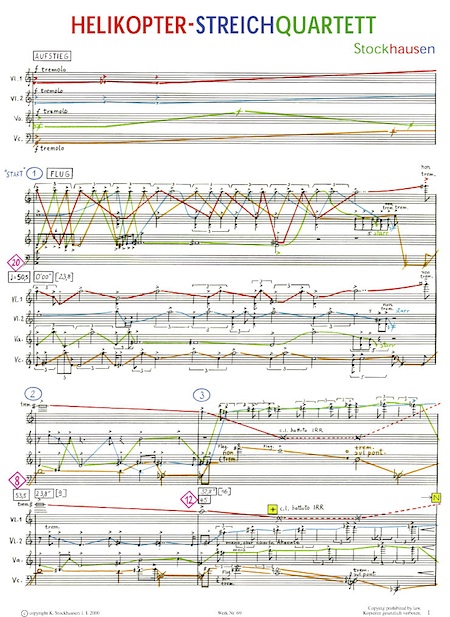
For the string quartet's music Karlheinz let himself be inspired by the rhythmic patterns and the sounds brought forth by the squeeshings and swooshings of a helicopter's rotor blades (which, as already said, during a performance are also mixed in live: each of the helicopter's rotors has its own microphone, and Stockhausen considers that the pilots steering the helicopters are as much musicians as are the string players). It accounts for the somewhat ‘excited and nervous' sounding result — a Dutch newspaper's review of the work's world premiere in Amsterdam in 1995 called it ‘hot tempered'— of four string players that during most of the piece perform manic tremolos in criss-crossing glissandi, which, from time to time, are accompanied by ‘Stockhausian counting', one of the 'signature elements' of Licht.
Given a number of fine musicians like the four stringers of the Elysian Quartet, playing the notes is the easy part. The difficult part is getting all of the technology to work; and overcoming the organizational and bureaucratic obstacles that a live performance of the piece will encounter. And contrary to what one might think, with the passing of the years it is not getting easier to perform the piece. Though there will be more and more young, ambitious and adventurous string quartets eager to give it a try (if only because the high visibility that the gimmick-y side of a performance in helicopters will give them), finding the right machines to fly in is getting more and more difficult. Like all technology also helicopter technology is advancing in a rapid pace. Most modern helicopters are no longer generating the quantity and sort of rotor blade noise that makes them suitable candidates for a Helikopter-Streichquartett performance. Within not too long only well conserved vintage machines will be left to do the job: collectors items, museum pieces; which is why this Stockhausen piece is running into the same sustainability problems as a whole range of other technology based art.
It makes it the more remarkable, as well as a sign of the quickly growing popularity (indeed!) of Stockhausen as a composer (and as a legend), that over the first weekend of this year’s October there were no less than two different performances of the Helicopter String Quartet: one in Italy and one in France. ( * )
The Arditti Quartet (who premiered the quartet in Amsterdam in 1995) did the piece for the opening of the 57th Music Biennial of Venice, on Friday October 4th. And on Saturday October 5th, the Elysian Quartet (who last year performed the piece four times for the world premiere of Mittwoch aus Licht in Birmingham) flew Stockhausen’s heli's over Paris. ( ** )
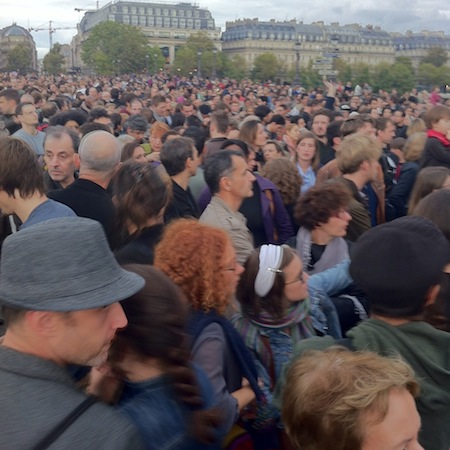
The French premiere of the quartet was produced by Chiara Parisi, director of the cultural program of the Monnaie de Paris (the Paris Mint), and also artistic director of the Nuit Blanche, a free annual Parisian all-nighter dedicated to fine 'art and culture'. Intended to mark 50 years of Französich-Deutsche Freundschaft ( *** ), as well as being very much a public relations and marketing move, the event was announced with a lot of silly hyperbole ("re-creation of the greatest musical performance of the 20th century", etc.), and quite a few of the onlooking Parisians on the Pont Neuf could be heard grumbling that inside the Mint they were throwing a party that was being paid for by their tax money.
For there was an inside and there was an outside.
The intimate on-invitation-only inside was in the lavish salle Dupré of the Conti Palace on the Quai de Conti, home to the Paris Mint. Here the performance could be followed via the video images that were shown on a couple of hi-res screens. It was also in the salle Dupré that the sounds were being mixed and made audible over a fine installation (the sound projection was taken care of by Ian Dearden and David Sheppard, aka Sound Intermedia).
We, le peuple, gathered outside at no more than a couple of hundred meters from there, where, on the Place du Pont Neuf an outside screen and a series of not-really-brilliant sounding outside speakers had been installed. The screen was relatively small, quite a bit smaller — or so it seemed — than the one put up at the Place de l’Hôtel de Ville for the screening of soccer matches or the Roland Garros tournament, though the crowd that gathered on the Pont Neuf on that cloudy Saturday evening (always on the brink of rain) was many times bigger than even the biggest crowd that I have seen watching tennis in front of the town hall. Properly following the performance in sound and vision on the Pont Neuf was possible only for those that had come early enough to be able to sit or stand reasonably close to the screen.
The helicopters of course should have done their takeoffs and landings in full view of the many, many spectators. But well, ok, one can understand that the Parisian prefecture considered this to be one bridge too far, even for a celebration of 50 years of French-German friendship. Therefore the helicopters and the Elysian quartet started their trip about eight kilometers (in a straight line; about ten by car) to the West, at the Auteuil Hippodrome.
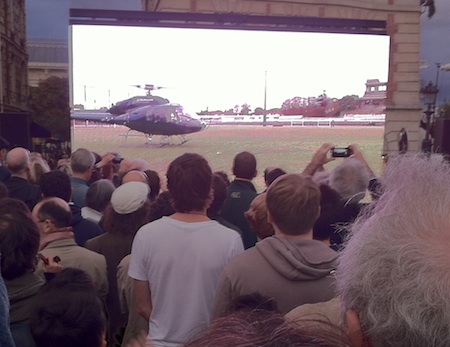
It took the technicians a considerable while before they managed to adjust the images outside to fit the screen’s size, but once this was done also the outsiders were able — or rather: forced — to follow in close up the rants of French radio & television personality Franck Ferrand, who was given the role of moderator and acted it out inside the Mint.
Stockhausen made this moderation an integral part of the piece and scripted its outlines in the score: before the start of the performance, the moderator should introduce the string players to the audience and provide a short description of the technical sides of the performance; after the helicopters have safely landed, the players re-join the moderator, who then is to introduce also the pilots to the audience. The moderator conducts a conversation with pilots and musicians, at the end of which the audience is invited to pose questions they may have about the piece and its performance.
That’s the idea.
Kurz und sachlich.
The Parisian event was webcast by ArteTV. Though I am not sure whether all of it was also webcast, the screening on the Pont Neuf lasted about two hours, of which only half an hour comprised the actual performance. We spent much of the remaining time watching three of the musicians in the back of a mini-van, looking out of the side windows, pulling up and adjusting their pants, scratching their heads and giggling during the ten kilometer drive from the Auteuil Hippodrome back to the Conti Palace. During that time moderator Franck Ferrand regularly wondered out loud whether it might be possible also to hear the musicians in the back of the van. “Yesterday during the rehearsal listening to them in the car was really interesting,” he said. But apparently no, this was not possible. We did not get to hear the musicians. They just continued to giggle and smile.
I doubt, though, that we missed much. In a short publicity clip for the event on Paris’s official YouTube channel, Jennymay Logan (violin) tells the viewers that she feels really peaceful playing music in a helicopter, “because it’s kind of white noise going on around you, and you block it out and you’re just focussing on the music and your place in the music”. And Emma Smith (violin) observes: “When the weather is nice, it is almost spiritual. But when the weather is bad, it’s horrible.” Most musicians have little interesting to say about music, at least not in public. So just let them play...
Meanwhile the moderator desperately tried to think of more things to say. He had already recited twice all he had read about Stockhausen and the piece while preparing for the evening (and I don’t think he heard an awful lot of Stockhausen before landing this gig), bombarded us with all possible superlatives and exaggerations, never stopped mentioning how very special, extraordinary and of great historical importance the event was that we were about to witness, or just had witnessed, and how very, very difficult its technical realization was. Of course this annoyed me. And it annoyed quite a few of the others who were watching and listening around me, most of whom actually seemed to know Stockhausen and his music pretty well. A lot better than Franck.
After a while one then also gets sort of fed up trying to see the whole circus on the screen as a campy theatre play, no matter how fun(k)(n)y it is to hear a Frenchman repeatedly pronounce: 'Karl Eins Stock Ausen'...
I don’t think it was only me.
When the pilots and the Elysian Quartet finally arrived to make their grand entrée, quite a number of the special guests had already left. On the screen the salle Dupré looked empty when the moderator asked the musicians the question that all that time had been burning on the tip of his tongue.
"...’ow was it? ...," Franck exclaimed.
After this, also the little audience that was left in the Paris Mint had no more questions. And outside, on the Pont Neuf, nobody was asked.
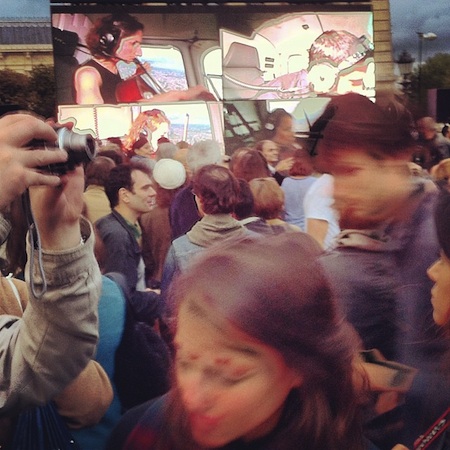
It was not the string players’ fault that, as the evening progressed, it became more and more difficult to escape the impression that in this Parisian rendition of the Helikopter-Streichquartett, Stockhausen’s music was merely a sideshow and that what really mattered was the staging of a spectacle to greater glory of the organizing and financing powers.
No, it was not the string players’ fault. The Elysian Quartet did a marvelous job. Judging from the parts that outside on the Pont Neuf we were able to hear, they performed the piece masterfully; or whatever: they did it with genuine enthusiasm, love and a lot of bravura.
So again: what more could one ask of them?
Oh yes, the helicopters. The helicopters did fly over the Pont Neuf, around 19h07, only three minutes later than originally announced. But when they did, they were flying so high that those that came to the banks of the Seine to see a swarm of helicopters must surely have been disappointed. There was little more than four tiny ‘flies’ that, for less than a minute or so, aligned high up in the air over Henry IV’s head.
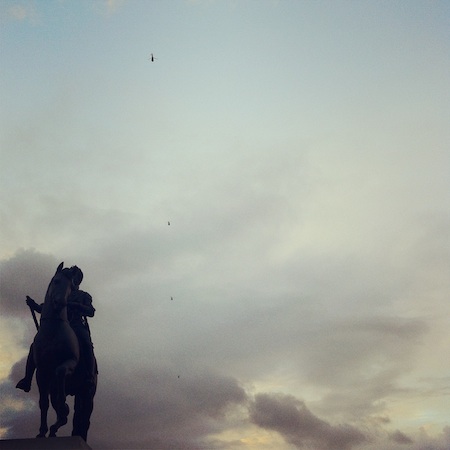
And no, it was not easy. And yes, the performance was plagued by a number of technical problems, the least of which was a lighting problem in one of the helicopters. Rather more dramatic were the glitches that at several points during the show caused series of loud electronic crackles, followed by longish interruptions in the transmission of the quartet’s sound and video.
This must be the reason that there is still no video of the Parisian Helicopter String Quartet up on Arte’s web site. It is also the reason that I am pretty happy that I managed to capture it all on my digital Zoom, thus — quite unintentionally — creating a fine piece of phornograpy.
Arte does not show you the video, or did not get the permission to do so. Their Nuit Blanche video screen is and remains black. But you can listen to my one hour documentary field recording, and re-experience the Helikopter-Streichquartett exactly as it sounded on Saturday October 5th 2013 on the very middle of the Place du Pont Neuf.
Almost daily, on Berlin based web Radio On.
You have my permission.
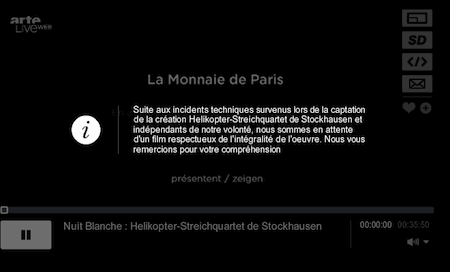
[ Added October 12th, 2013, 11h00: ArteTV put the complete original, glitchy, video of the Elysian Quartet's Nuit Blanche performance of the Helicopter String Quartet back online ...
Added January 12th, 2014: ... meanwhile, however it has been replaced by a short, five minute, extract... :
]
notes __ ::
(*) Also, on the 6th of October, in the Royal Festival Hall in London, there was a performance of Gruppen for three orchestras — which musically is far more demanding; and, arguably, also more interesting. [
^ ]
(**) The October 2013 concerts in Venice and Paris were part of, respectively, the 6th and 7th occasion of Helicopter String Quartet productions, and they were the work's 11th and the 12th public performance.
Here is the full list of the work's performance, from its 1995 premiere until the Parisian performance of Saturday October 5th 2013 (thanks to Kathinka Pasveer, who was so kind to send me an email which provided most of this information.)
1-3 : Amsterdam (the Netherlands), June 26th 1995. World premiere, 3 performances by the Arditti Quartet.
4 : Salzburg (Austria), August 22nd 2003. Stadler-Quartett, on the occasion of Stockhausen's 75th birthday.
5 : Rome (Italy), January 18th 2009. Arditti Quartet.
6 : Boswil (Switzerland), July 3rd 2011. casalQuartet.
7-10 : Birmingham (UK), August 22nd-25th 2012. 4 performances by the Elysian Quartet, as part of the world premiere of Mittwoch.
11 : Venice (Italy), October 4th 2013. Arditti Quartet.
12 : Paris (France), October 5th 2013. Elysian Quartet.
[
^ ]
(***) In 2013 we celebrate not only the 50th anniversaries of the audio cassette and of live looping, but also that of the Elysée Treaty, the Treaty of Friendship, established by Charles de Gaulle and Konrad Adenauer on January 22, 1963 for reconciliation between the France and Germany. [
^ ]
Read about Karlheinz Stockhausen on the SoundBlog:
(2014, march 08) - "12 - 11 - 9 - 10 - 3 - 6 - 7 - 1 - 2 - 8 - 4 - 5"
(2013, october 12) - "At 19:07 the four helicopters flew over the Pont Neuf"
(2010, march 30) - on-g'luk = un-luck, that is: malheur, twice ...
(2008, february 12) - Karlheinz's Song of Praise
(2004, september 06) - vicky's mosquitos
(2004, august 19) - alLicht
tags: Karlheinz Stockhausen, Paris, phornography
# .443.
comments for "At 19:07 the four helicopters flew over the Pont Neuf" ::
|
Comments are disabled |